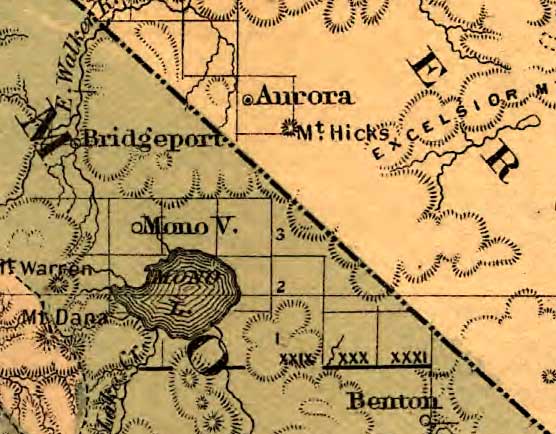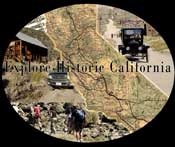|
Tucked away in
the hills north of Mono Lake in Eastern California, lies the faded
town of Bodie, California. The once bustling boomtown where an
arguable number of both good and bad citizens, lived, worked and
played during the mining zenith of the 1870’s-1880’s, stands as a
mere shadow of it’s former self in the new millennium. Somewhere
between five and ten percent of the original buildings struggle to
survive in various degrees of arrested decay, maintained as part of
the California State Parks system. Modern tourists come from all
over the world to explore its colorful and covetous past.
 |
|
Bodie
didn't even rate a dot in this 1876 California-Nevada
map.
Map
courtesy, Library of Congress collection |
W. S. Bodey and
Black Taylor were among the first to wander into the hills in search
of color in July, 1859. Later that fall, while preparing to winter
on Silver Hill near their claim, a blizzard hit. Bodey perished as
he struggled through the deep snow with supplies. Prospectors and
common folk eventually followed the cry of gold. The town that
sprouted near Bodey and Taylor’s original strike was named after W.
S. Bodey.
 |
| The
town of Bodie, despite its 8300 foot elevation, sits in
a bowl-shaped depression on high desert terrain. The
town never had trees and had to import all its wood for
fuel and construction. |
By 1864,
journalist J. Ross Browne reported scattered primitive miner’s
habitations and the promise of rich mining operations on the Bodie
Bluff. A few families such as the Butlers, Horners, and Kernohans,
lived in the isolated camp. The women set up housekeeping while the
men ventured from their normal trade as blacksmiths in Aurora,
Nevada and tried their hand at prospecting and mining.
 |
|
Bodie is shown on this 1885 railroad map, but Aurora has
disappeared. Map courtesy, Library of
Congress collection |
The population
would swell in the next few years to nearly fifty residents, twenty
wood and adobe houses and one boarding house, all located on the
hill close to the mines. At the pinnacle of mining in the early
1880’s, the population was reported to be anywhere from 7,000 –
10,000, complete with miners, women and children, gunfighters,
vigilantes and whores.
The number of
Bodie residents, necessary businesses and entertainments would wax
and wane with the production of the big mining companies that moved
into the area on and off through the 1920’s, and the amount of ore
that was pulled out.
Midwinter, 1883,
Bodie saw an economic downturn, with all but six or seven of the
larger mines closed and only 2,500 citizens remaining. Many
businesses would clear shelves, board windows and lock their doors
for the last time. The rip roaring mining town that Rev. F. M.
Warrington had once touted a “Sea of sin, lashed by tempests of lust
and passions” in 1881, struggled to hang on with barely 500 souls by
1886. A letter from the editor of the Bodie Evening Miner to
the editor and publisher of the Los Angeles Evening Express
declared real estate in “utter stagnation.”
James Stewart
Cain, a prominent citizen, businessman and banker, saw promise in
Bodie. He bought dormant mines, built new hoisting works, a cyanide
plant, and leased properties to others. By 1920, E. J. Clinton
secured a lease from Cain, and re-worked old tailings. Clinton
brought his family with him, and moved into the old railroad
office on the bluff. His children attended the Bodie school, and he
and his wife kept the Methodist Church going by renovating it and
reviving Sunday sermons, which they preached themselves. Clinton
brought with him thirty employees who lived in the fading town
during this time.
 |
|
Bricks
and a steel door are all that remain of Cain's bank
after it was destroyed in the 1932 fire. |
The Treadwell –
Yukon Co. joined in mining efforts and brought in another 150
workmen. The population grew from 30 to 400. The school was
re-painted, saloons opened up, automobiles came to town, congesting
streets where horse and buggy once ruled.
It may have been
Prohibition in the rest of the United States, but Treadwell-Yukon’s
employees were thirsty. Ice cream parlors served as saloons when the
Feds weren’t around checking up on things. Gambling and girls were
still sport as well. Tourists began wandering in to see a slice of
the Old West.
By the 1930’s,
attempts to extract gold and silver from Bodie’s waste rock failed
and the mining companies started leaving. By 1931 Bodie had only a
few remaining families. The following year, a little boy now known
as "Bodie Bill" was disappointed because he was served Jell-O
instead of cake. He started a fire destroying seventy-five per cent
of Bodie’s business district. With major hotels, stores, and banks
gone, combined with the agonizing demise of the mining industry,
most of Bodie's remaining residents moved on. The population once
again dwindled to fewer than 30 people.
The Bell family
pursued small scale mining efforts at the Noonday mine in September
of 1932. A little over $1,000 was recovered. Bridgeport headlines of
April 1933 talked of big strikes in the ghost of Bodie.
In 1996, Bobbie
Bell, told author Michael Piatt (Bodie: The Mines Are Doing Well),
that at the time of the old camp's renewed interest he was 18 years
old. His father, grandfather and a couple of neighbors had
exaggerated their efforts. A few remnants of high grade rock left
over by the last mining camp were scratched out of the old stopes,
but the big ore body was gone.
As the last two
underground leases were being worked in 1935, James S. Cain left
Bodie. Always hopeful, Cain purchased many of the remaining
buildings and began to lease them off. A watchman was hired to look
over the properties, and keep the near ghost town from being totally
scrapped by vandals and souvenir hunters.
The
Western-Knapp Engineering Co. came in with a cyanide plant in
October, 1936. A modern complex was built on the site of the former
Treadwell-Yukon plant. A dam was built to impound tailings in Taylor
Gulch. By October 10, Bodieites watched as the 250 ton per day
Roseklip plant started up.
A dance was held
in celebration. The Bodie school house re-opened in expectation, as
35 employees moved into town with their families and the population
increased to 113. The deteriorating remains of original Bodie
buildings served as homes for the families, with no efforts towards
re-building the losses of the 1932 fire.
The Miner’s
Union hall opened its doors after twenty-five years of silence. A
Bodie housewife played the piano and a workman or two picked up the
banjo, fiddle or guitar for an impromptu dance. The Roseklip Mines
Co. struggled, with little profit, until 1942 when the decision was
made to shut it down. After WWII, new management came in, and began
refitting the plant. A fire broke out during the work crew lunch
break, and burned it into the ground, literally turning dreams of
another pay dirt into smoke.
 |
|
Grass
grows along Main St. in Bodie. Two major fires, and
relentless weather erased many original buildings.
Today, the remaining structures are maintained in a
state of "arrested decay." They won't be restored, but
will be preserved as they were in 1962 when Bodie became
a California State Park. |
Bodie never
totally went to the ghosts. The J. S. Cain Co. held on to the old
town after J. S. Cain’s death in 1938. A good portion of what fires
didn't destroy was lost to WWII scrap metal drives. Visitors came in
search of the old west, and often took off with a piece of it for
their personal collections, in spite of the watchmen who had been
hired to keep them from doing so.
 |
|
Visitors peer into the Bodie school house. |
What remained
served as a backdrop for Hollywood’s jaded view of the old west in a
few movies. The Miner’s Union hall was turned into a museum with a
collection of artifacts from the old mining town’s past. The few
Bodie residents who had managed to hang on to their homes for
vacation purposes, lost all but a quarter of what they were worth
when the town was sold to the State of California.
But the memories
linger on in 168 well-worn buildings that remain in the care of the
park rangers who brave the harsh Bodie winters to preserve and
protect them, and in the historians who record the stories they have
to tell. The ghost of Bodie live on in the hearts of all who visit
it’s detained disintegration.
Bibliography:
|
